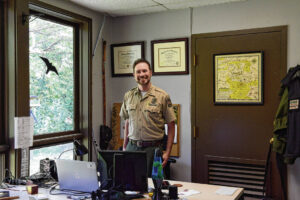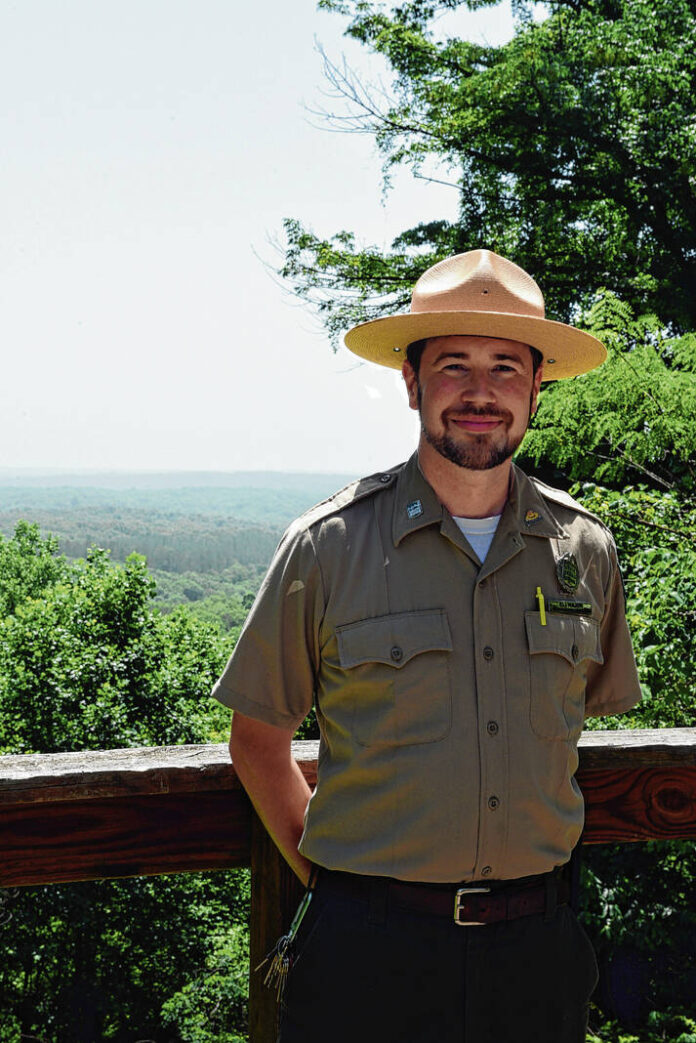Eli Major has been told more than once that the view from his office is the best in Indiana.
His desk is adjacent to an east-facing window. Just outside, native birds visit feeders and wildflowers sprawl across the lawn. Beyond the flowers and feeders, a pathway leads to a grand vista looking over Brown County’s rolling hills.
Major walked down the path from his office on June 15 and took in the view, hills cloaked in summer haze. The view is just one of the many vistas in Brown County State Park.
Since December, Major has been enjoying this view and his new role as the state park’s new interpretive naturalist.
Former interpretive naturalist Patrick Haulter was promoted to assistant property manager of the state park last summer.
It has now been six months since Major was hired to educate all guests to the state park. He continues to get acquainted with the vast 16,000 acres of public lands.
Major is a southern Indiana native. He was born in Clarke County, went to high school in Dubois County and attended undergrad at Indiana University.
After graduating, he spent the first phase of his career as a public high school teacher — licensed to teach social studies, U.S. government, economics and history — before ultimately deciding it was not a great fit.
“It’s a challenging career,” he said. “I respect teachers very much.”
He decided to try something else, enrolling at University of Wyoming for graduate studies. There he obtained a masters degree in public administration in natural resource management.
He then applied for seasonal summer job at Spring Mill State Park, which is where he worked for four years.
Now he finds himself learning the ins and outs of the beautiful, rolling hills of Brown County.
He attributes his love of the outdoors to his upbringing. His father has a degree in agricultural forestry from Purdue University.
Major also grew up on a tree farm that bordered the Clarke State Forest.
“I’ve been outside quite a bit through my life. When I realized I could plausibly turn that into a career, I decided to pivot to that,” he said.

Enthusiastic to serve
As interpretive naturalist, he finds himself covering an array of different responsibilities. He is largely in charge of visitor services, natural resource and wildlife management.
Education does play a role in visitor services, the mission of naturalist of state parks being to educate guests about the park, with a “robust” program schedule on various park topics, Major said.
Attending IU, Major had visited Brown County State Park a few times when he was in college. When he realized the naturalist position was going to be open, he decided to arrange a visit.
He was drawn right in by the vastness and wild feeling of the park, he said.
Major spent his summer breaks off as a teacher traveling to different national parks. Picking a favorite national park is a difficult task, Major said, but he’d have to say Mount Rainier National Park, with honorable mentions North Cascades, Crater Lake and Lassen Volcanic as well.
He said that he has more than 500 submissions to the National Park Service, starting before his graduate school years and continuing to apply after graduation.
“These jobs are highly competitive,” he said. A friend of his with the NPS said that some jobs receive up to 10,000 submissions.
“It’s hard to break into the National Park Service, but Brown County is like working at a national park, from my perspective,” he said, noting the park’s size and diverse activities.
“I absolutely love this place. You can’t hear any manmade sounds. Not something you can do at many state parks.”
He has been busy learning the ins and outs of the state park. There has been a lot to learn about his new role too with it being an administrative, educational and visitor-oriented job.
“It’s been quite a learning curve. But I’m up for the task and I have a great deal of passion for this career,” he said.
“I didn’t sign up for this job because it would make me rich or prestigious, I am a true believer in public lands and outdoor recreation and mindfulness in wild areas.”
Something Major did not fully realize before taking the job on was the lasting impact he can have on the park, leaving a personal legacy as the interpretive naturalist.
“Working at a state park for years, you’re going to initiate, execute and finish projects that people will enjoy for decades. (That’s) something I never considered in my life before,” he said.
He is not going anywhere either. He continues to plan for the future, adding events or programs to his calendar. The next few years will be busy for the state park — there is an eclipse in 2024, the state park centennial in 2029 and the anniversary of Kin Hubbard’s death in 2030.
The park was opened in 1929 and in 1932 was dedicated to Hubbard, the cartoonist of Abe Martin, the fictional backwoods Brown County cartoon character created in the early 1900s.
Abe Martin is the namesake for the original lodge, which opened in 1932, three years after the park was established.
The park was established in 1924 as the Brown County State Game Preserve by the efforts of Lee Bright, a lifelong resident of Brown County, and Richard Lieber, often referred to as the father of Indiana state parks.
It wasn’t intended as a park at that time, but “its picturesque qualities were an attraction to the general public, and portions of its acreage came to be used informally as a park — especially the ridgetop known as ‘Weed Patch Hill,’ with its sweeping views and iconic fire tower,” a draft of the National Register nomination said.
It was accepted into the Indiana Register of Historic Sites and Structures in October of 2020 after at least four years of research and documentation by Indiana Landmarks staff and the Indiana Department of Natural Resources, with support from local group Peaceful Valley Heritage.
For now Major said he plans on staying afloat and “not rocking the boat,” continuing Haulter’s programming.
Brown County State Park has several legacy programs that Major said he is enthusiastic to continue, such as the Winter Hike Series, Rock Fest, Snake Fest and the Spring Wildflower Foray. He’s also an advocate for the Live Raptor Shows put on by the Indiana Raptor Center.
In terms of more daily programs, he enjoys night hikes and stargazing.
“Ambition will come in my second year. It’s a big park to learn,” he said.
“I’m motivated far beyond a lot of the typical career goals. I’ve joked with several people that I’m married to Brown County State Park work. It’s a real dream of a job. Still getting over the feeling of being here – pinch me.”
Major fell in love with the park when spring made its debut this year — filling the empty spaces in the forest with greenery once again.
His daily commute includes driving by Hesitation Point on his way in and out.
“When I would go to leave it would be different,” he said. “It just changed by the hour. It’s just a really an intangible sort of feeling to see the vistas and know them intimately, even the subtle changes from day to day.”
“It’s a real privilege and honor to be here and the town of Nashville and surrounding community and county just seem really, really lovely. I have such a wonderful network of volunteers and locals that really care about this park. Really easy to feed off of that enthusiasm and feed back into it. To any reader, I’d encourage to come see the best and biggest state park in Indiana.”





